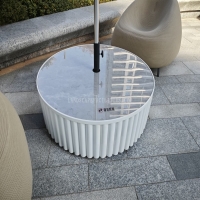Welcome to the website for landscape facilities products and knowledge.
How does the table’s design minimize the risk of injury from sharp corners?
Modern table designs incorporate multiple safety features to minimize injury risks from sharp corners. The most fundamental approach involves replacing traditional 90-degree angles with rounded corners, which significantly reduces the impact force when accidental contact occurs. Designers calculate optimal curvature radii that maintain aesthetic appeal while ensuring maximum safety, particularly crucial for households with young children who are prone to running and falling.
Beyond simple rounding, many contemporary tables feature beveled edges that create gradual slopes rather than abrupt angular transitions. This design technique distributes potential impact across a broader surface area, preventing concentrated pressure points that could cause cuts or bruises. Some manufacturers enhance this further by adding soft rubber or silicone edge-banding materials that absorb shock upon contact.
The furniture industry has developed specialized safety standards, such as the European EN 12520 and American ASTM F2057, which mandate specific requirements for corner sharpness in consumer furniture. These regulations require that all edges and corners pass rigorous impact tests, ensuring they either collapse upon hard impact or feature energy-absorbing properties.
Advanced materials contribute significantly to corner safety. Tables constructed from medium-density fiberboard (MDF) often undergo specialized molding processes that create inherently rounded profiles. Solid wood tables incorporate steam-bending techniques to achieve smooth curves, while metal frames utilize tubular construction with welded end caps that eliminate raw edges.
Many safety-conscious designs incorporate dual-radius corners—a tighter curve at the very edge that transitions into a broader curve along the table's perimeter. This sophisticated approach addresses both initial contact points and secondary impact zones. Some manufacturers implement "crumple zones" in table construction, using slightly softer materials at corners that deform minimally upon impact, much like automotive safety features.
The evolution of table leg connections has also improved safety. Modern designs often position legs inward from the corners or use central pedestal bases that completely eliminate corner legs—common tripping hazards. For folding tables, safety mechanisms ensure edges automatically lock in rounded positions when deployed.
Commercial and educational furniture frequently incorporates high-visibility edge detailing that serves dual purposes: creating visual contrast for visually impaired users while providing extra impact resistance through reinforced materials. These edges often combine thermoplastic polymers with internal reinforcement ribs.
Recent innovations include tables with active safety systems—corners that temporarily compress upon detecting pressure spikes, or illuminated edges that automatically brighten in low-light conditions. While primarily used in healthcare and senior living facilities, these technologies are gradually entering residential markets, representing the future of injury-preventive furniture design.
Related search:

Recommendation
Round metal tube border design table with tempered glass or granite countertop on the top.